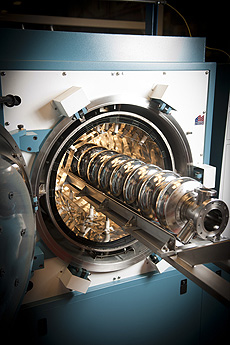Fermilab contributes to SLAC LCLS-II with cutting-edge technology and expertise
 |
| Fermilab is developing superconducting accelerating cavities similar to this one for SLAC's Linac Coherent Light Source II. Photo: Reidar Hahn |
Now one year into its five-year construction plan, the Linac Coherent Light Source II, an electron accelerator project at SLAC, will produce a high-power free-electron laser for cutting-edge scientific explorations ranging from refined observations of molecules and cellular interactions to innovative materials engineering. Cornell University as well as Argonne National Laboratory, Lawrence Berkeley National Laboratory, Fermilab and Thomas Jefferson National Accelerator Facility are partners in the SLAC-directed project.
"We at the laboratories are all developing close ties," said Richard Stanek, Fermilab LCLS-II team leader. "The DOE science lab complex will be stronger for this collaboration."
In 2015, Fermilab will intensify its LCLS-II contribution in the overlapping areas of superconducting radio-frequency (SRF) accelerator technology and cryogenics, critical components that distinguish LCLS-II from SLAC's current LCLS facility, whose laser production has enabled noted scientific investigations in cancer treatment and other important areas.
SLAC physicist Marc Ross, LCLS-II cryogenics systems manager, said LCLS cannot keep up with scientists' requests for use. The existing LCLS facility and LCLS-II combined will offer researchers laser X-rays with a wide range of properties.
"This new approach will transform the repetition rate of LCLS — from 120
pulses per second to up to 1 million per second," Ross said. "This will allow a completely new class of experiments and, eventually, a much larger number of experimental stations operated in parallel."
Fermilab Technical Division physicists Hasan Padamsee, division head, and Anna Grassellino and their team are working on SRF technology for LCLS-II, in particular on implementing Fermilab's two recent findings to reduce the needed cryogenic power. In one innovation, known as nitrogen doping, Grassellino found that infusing a small amount of nitrogen gas when preparing the superconducting cavities — the structures through which beam is accelerated — reduces two main causes of the usually expected resistance to radio-frequency currents.
"It is exciting to see our discovery becoming an enabling technology for LCLS-II," Grassellino said.
Grassellino's high-Q team has also found that the cavities' cooling dynamics significantly helps expel magnetic flux, another major source of cavity power dissipation. The Fermilab high-Q team, together with Cornell University and Jefferson Lab, are currently working on calibrating the cooling thermogradient for LCLS-II.
Stanek said Fermilab is advancing its SRF work with its LCLS-II participation.
"I see this project taking us from an R&D phase of SRF technology, which is where we have been the past six to eight years, and moving our expertise into production," Stanek said. "This is a big step forward."
Fermilab and Jefferson Lab are working closely together on the cooling systems that enable the cavities' superconductivity. Fermilab scientist Camille Ginsburg leads LCLS-II cryomodule production at Fermilab, and Fermilab engineer Arkadiy Klebaner manages the LCLS-II cryomodules distribution system.
"To build a high-energy beam using SRF technology, LCLS-II needed expertise in cryogenics," Klebaner said. "So Jefferson Lab and Fermilab, who both have special expertise in this, were ready to help out."
A cryogenic plant generating the refrigeration, a cryogenic distribution system for transporting the refrigeration into cryomodules and the cryomodules themselves make up the LCLS-II cryogenics. Jefferson Lab will provide the cryogenic plant, and Fermilab is in charge of developing the cryogenic distribution system. Jefferson Lab and Fermilab are jointly developing LCLS-II's 35 cryomodules, each one about 10 meters long.
Fermilab's contribution draws on the Tevatron's cryogenics and on SRF research begun for the proposed International Linear Collider. The lab's LCLS-II experience will also help with developing its planned PIP-II accelerator.
"So when we build the next accelerator for Fermilab, PIP-II, then we will have already gotten a lap around the production race course," Padamsee said.
All labs have something special to contribute to LCLS-II, Ross said.
"The Fermilab team have figured out a way to make this kind of accelerator much better operating in the cold temperature that superconducting technology requires," Ross said. "It is worthy of special recognition."
—Rich Blaustein
|